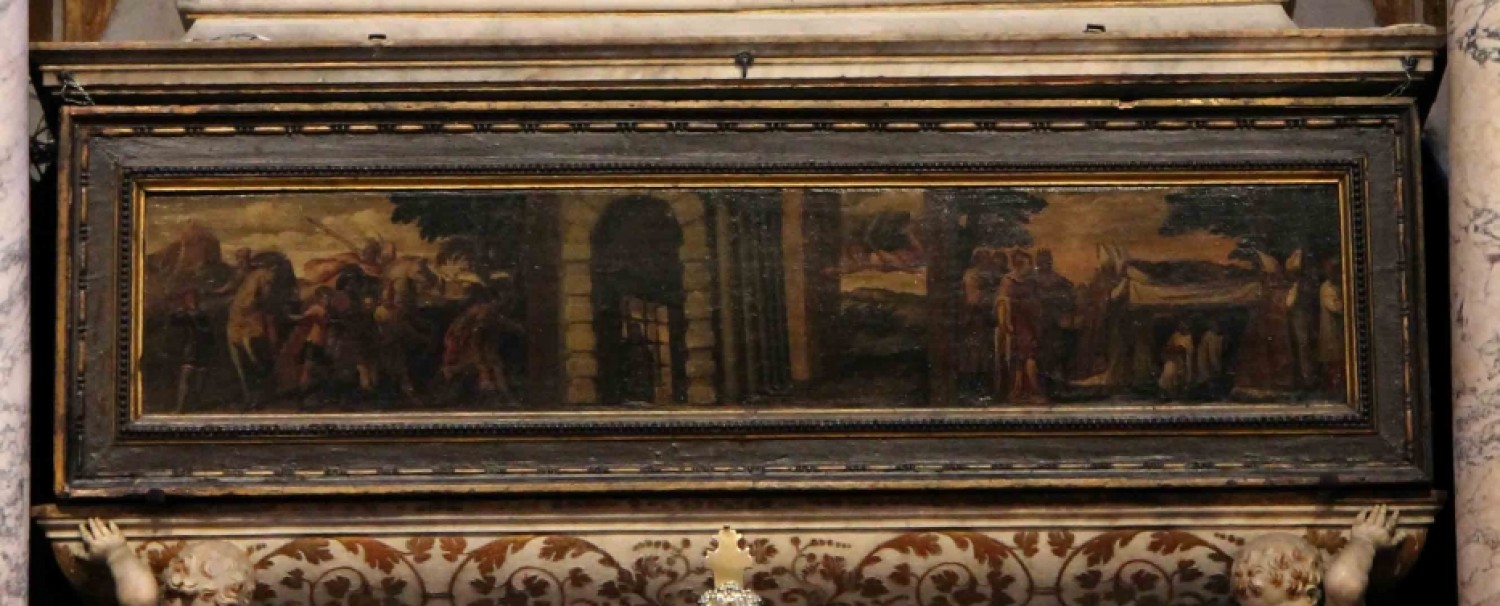Sometimes it is overshadowed by the presence of the nearby superb Scuola di San Rocco, considered the temple of the art by Tintoretto. Sometimes people hastily pass in front of it, towards Rialto. Sometimes, one simply forgets the enormous importance that relics had in ancient times, and until at least the mid-nineteenth century. But none of these is a valid reason to miss a visit to the Church of San Rocco.Who was San Rocco, whose body is preserved in this church (fig. 1)? He was one of the most important late medieval saints, a thaumaturge (as he performed miracles) and apotropaic (because he was invoked to by devotees to avoid misfortunes, especially plague epidemics). Lived between around 1340 and 1380, his biography is woven with legend. He was born in Montpellier, France, and was destined by the family to become a doctor. At the age of twenty, he abandoned his wealthy life and went on a pilgrimage to Rome, where he experienced the health scourge of the time: the plague. Devoting himself for a long time to the care and relief of the plague stricken, he contracted the disease himself. He retired in a wood near Piacenza, where according to legend every day a dog named Orestes fed him with bread, and an angel quenched his thirst with water. For this reason, in the most consolidated iconography (fig. 2), Rocco shows the clothes of a pilgrim, carries borzachietti at his feet, in his hand he holds the pilgrims’ stick, and shows the plague bubo appearing on his leg. However, after forty symbolic days, the faithful Rocco who trusted so much in the Lord ... recovered! On the way home, in the duchy of Milan he was captured, mistaken for a spy, and put in prison in Voghera. Here after a few days he died. He was probably canonized as early as 1414. Since his death, and even before his sanctification, Rocco was invoked as the main protector of the plague victims. Why then is the body of San Roque located in Venice? In 1485 some Venetians brought Roque's body to Venice. How and why they did it are issues that historians have debated for centuries. Some believe that the theft of the relics was deliberately commissioned by the Scuola di San Rocco for increasing prestige; others that the Camaldolese friar Mauro brought Roque's body from Voghera to Venice to satisfy a personal vow: he would also have left one Roque's arms behind, so that even that church would continue to retain a portion. Nonetheless, the versions of Roque's death are multiple, and for example the biographer Francesco Diedo, in 1479, commented that Roque died in his native Montpellier. What the legend and what the reality, for now we do not know! It is what it is, the first church of San Rocco in Venice was built by architect Bartolomeo Bon, short after the theft of the Saint's body. Of the original medieval structure only part of the apse area survives. The tomb structure we see today is still the original one, built between 1517 and 1524 on a design by Venturino Fantoni. You can also appreciate the original urn cover, painted with Stories of Roque by Andrea Schiavone, which conceals by canon law the relics of the Saint, exhibited only on August 16.
The church boasts many artistic beauties. The two most well-known masterpieces are kept on the walls of the presbytery. These are two canvases that Tintoretto painted in 1549, well before the beginning of his adventure at the nearby Scuola Grande. The one on the left wall depicts Saint Roque in prison, with skilful use of light. While in the left-hand one we see Roque visiting some plague victims (fig. 4). Set in a large hall, which will resemble a Venetian lazaretto, illuminated only by the dim light that enters the few windows on the right, many ill show their bodies battered by buboes. In the centre Roque, with his head circumfused with light and dressed as a pilgrim, visits a patient who has removed his bandages to show the inguinal bubo. The dog Orestes accompanies him quietly. At least another canvas by Tintoretto deserves attention: it is located on the nave right wall, in an elevated position, below the windows. Originally, these were two separate paintings which adorned the doors of a pieco of furniture in the sacristy. They were then joined together, and in the 18th century the painter Sante Piatti enlarged it to adapt it to the new church structure. Tintoretto had represented plague-stricken Roque in the wood, while his faithful companion Orestes, sent to him by the owner of the place, reached him with a loaf of bread. Piatti created a fake frame around Tintoretto's painting, placing spectators on the sides who admire and pray at the 16th-century painting. Really interesting! The diligent observer will not fail to note that the church has significant Rococo works, placed here following the reconstruction in 1725. The altarpieces of the first side altars, by the great master Sebastiano Ricci, particularly stand out, showing miraculous episodes on which pilgrims could meditate when they visited the church. The one on the left wall commemorates the discovery of the Holy Cross in Jerusalem by Saint Helena: the Golden Legend has it that Constantine's mother brought a corpse near to the newly found cross of Christ and the man immediately resurrected. The one on the left is dedicated to a miracle of San Francesco di Paola, who brought a child back to life. Plan to visit this site with me, to better appreciate all treasures of art and faith .
